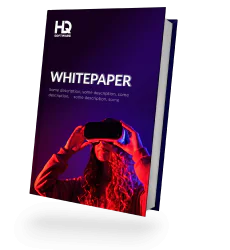AR and VR Technologies in the Workplace: Current Trends
Integrating AR and VR in the Workplace
Employee Training and Skill Development
Increased Efficiency and Productivity
Improved Safety and Risk Management
Augmented Reality (AR) and Virtual Reality (VR) have emerged as the latest trends in the workplace. A notable 39% of companies are already leveraging these technologies to develop virtual training simulations.
Virtual reality software give workers innovative ways to interact with data, objects, and virtual environments, resulting in more engaging and productive job processes.
As head of production at HQSoftware, I’ve participated in several AR/VR projects involving employee training, such as VR training on caring for people with dementia. In this article, I’ll summarize my experience and the results our clients experienced, and provide some valuable tips on creating a workplace revolution with AR/VR.
AR and VR Technologies in the Workplace: Current Trends
Integrating AR and VR in the Workplace
Employee Training and Skill Development
Increased Efficiency and Productivity
Improved Safety and Risk Management
Research has found that AR and VR technologies have had an impact on 23 million jobs worldwide, offering advancements in productivity, innovation, and effective training. This is possible when companies implement Augmented and Virtual Reality in the workplace for:
As important as these three applications are, that doesn’t cover all the potential uses for AR/VR in the workplace that I’ve encountered in my practice. So, let’s look at some more ideas for how you can transform the way your teams work.
Based on my experience, Augmented and Virtual Reality are becoming popular in the workplace for the following reasons:
How does it work in practice? Let’s explore some examples.
Students who are learning through listening passively to lectures often find it difficult to apply their learning in real-life situations. In contrast, immersive AR and VR training helps trainees acquire these skills more rapidly and safely.
Studies show that learning a skill that typically takes about 2 hours to pick up in a traditional classroom setting takes about 30 minutes through VR simulations. As a result, VR learning results in both time savings and better skills retention.
Among the most popular use cases I’d highlight:
While we’re discussing the impact of VR and Augmented Reality in business, it’s important to note that it can lead to increased operational efficiency and productivity. Research conducted by the IBM Institute of Business Value found an average 32% increase in productivity and 46% decrease in task completion time.
For example:
For instance, Boeing uses Augmented Reality guidelines that display aircraft wiring schemes in front of technicians, enabling them to work without the need for physical interaction or holding any additional tools. This has reduced wiring production time by 25% and boosted productivity by 40%.
Want to create an AR/VR solution to revolutionize your workplace? We’re ready to help!HQSoftware has a team of skilled professionals ready to tackle the project. Ask me!
Anna Halias
Business Development Manager
What percentage of your customers leave with nothing because they could not get enough information or the sales specialist did not seem very persuasive? Well, AR/VR can help with that.
By training in VR, your workers can practice handling customer inquiries, resolving issues, and delivering sales pitches in virtual scenarios. This helps improve their communication skills, product knowledge, and customer interaction abilities.
For instance, Walgreens is employing Augmented Reality to onboard staff for its new partnership with Kroger Express stores. Through digitally recreated 3D simulations, employees can receive hands-on training in handling various customer service scenarios and replenishing inventory.
Two other ways you can use AR and VR effectively in retail are virtual product demonstrations and virtual try-on and fitting.
An AR or VR immersive experience creates a better understanding of the product’s features, benefits, and functionality. In real estate, for instance, AR technology allows you to visually showcase prospective construction projects on the actual building site, providing a clear understanding of how the land will be developed in the future.
In this way, potential customers can examine the building in detail, which increases confidence in purchasing and makes it easier for salespeople to successfully close deals.
How do modern businesses use AR to increase their revenues and outperform their industry competitors?

According to AFL-CIO statistics, in the US alone more than 100,000 employees each year are disabled or even lose their lives due to workplace injuries and occupational diseases. To reduce the possibility of harm and promote an effective safety culture in the workplace, you can simulate hazardous situations in Virtual Reality. The research proves that using VR in the workplace enhances overall occupational safety and helps assess risks.
AR and VR can be used in safety training across three main areas:
For example, Ford has employed VR to record, using motion sensors, how employees move during equipment assembly, helping the company reduce injury risks by 70%.
During my career, I’ve watched a steady increase in mobile and cloud computing, and now the rise of Virtual and Augmented Reality, with a potential market value of about $200 billion by 2030.
With an increasing global demand for VR technology, an estimated 171 million users are currently utilizing it, and this number is always growing.
Besides gaming, emerging AR and VR use cases are predicted to expand in:
While our company has been providing AR and VR solutions for over a decade, the most significant rise in their popularity has come in the past five years. For example, our portfolio has experienced a notable increase of 30% in VR medical training over the past two years.
Alexey Dunaevsky
Educational Design Lead
at HQSoftwareSubjects that once bored students seem to come alive through immersive experiences, opening up new interactive possibilities that significantly boost retention.
Having worked at HQSoftware on AR/VR projects across various industries, I know that there are many nuances that need to be considered.
For example, when developing Bodyscope, we had to set proper lighting in the simulation room to provide realistic visibility for the 3D models, avoiding backlighting or very dark areas.
In creating VR occupational training, we solved the problem of ensuring the correct hand position to properly carry out actions such as screwing or cutting, replicating the real-life details. It’s important to ensure that users acquire skills in the right way.
We also know that when developing AR/VR solutions, it’s important to consider:
Taking into consideration all the factors mentioned above, we at HQSoftware deliver highly realistic and immersive AR and VR solutions. We carefully evaluate the project’s requirements before developing to ensure that the final solution will best meet your demands.
Contact us to find out more about our AR and VR development services.

Head of Production
To ensure the outstanding quality of HQSoftware’s solutions and services, I took the position of Head of Production and manager of the Quality Assurance department. Turn to me with any questions regarding our tech expertise.
We are open to seeing your business needs and determining the best solution. Complete this form, and receive a free personalized proposal from your dedicated manager.

Sergei Vardomatski
Founder